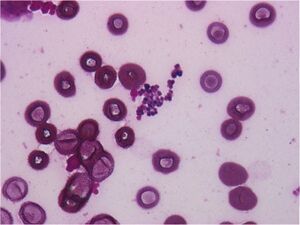Gemella palaticanis
Classification
Bacteria, Bacillota, Bacilli, Bacillales, Staphylococcaceae, Gemella, G. palaticanis

Species
Gemella palaticanis.
Description and Significance
Gemella palatincanis is a relatively new species of microbe under the genus Gemella. Gemella, first discovered in 1938, consists of catalase negative, facultatively anaerobic, Gram-positive, coccoid shaped organisms. Microbes within this genus are often arranged in pairs or tetrads. It was only recently that two species of Gemella were recognized, after research found that they were biochemically incompatible with the original assigned genus. Gemella palatincanis is another recently added species after it was extracted from the oral cavity of a canine. They are unique among the rest of the genus as palaticanis has the ability to ferment lactose (Collins). In other words, this species is capable of breaking down the sugars in food, hence producing lactic acid.
Genome Structure
There is vey little known of the genome structure of Gemella palatincanis. However, the genome of this species is a single, circular chromosome, similar to many other microorganisms. The genome size of the Gemella is typically ranged from 1.60-2.05Mb. The DNA G+C content can we as low as 30-40%. Different species of Gemalla are distinguished based on 16S rRNA gene sequencing (Schoch).
Cell Structure, Metabolism and Life Cycle
The cells of Gemella palatincanis are non-spore-forming cocci that typically appear in clusters or small chains. All Gemella carry the genes necessary for incorporating phosphorylcholine into their cell walls and are able to encode certain choline-binding proteins. They are facultatively anaerobic, using oxygen to produce ATP when it is present, but having the capability to switch to fermentation when oxygen is not present (García López). There is little known of this species metabolism or complete life cycle.
Ecology and Pathogenesis
Gemella are most commonly known to be found within the human mucous membranes, including but not limited to : the oral cavity, the respiratory tract, and the gastrointestinal tract. The genus has been known to cause local and widespread infection. It may act as a causative agent in different infections, such as infective endocarditis, brain and pharyngeal abscesses, as well as empyema (Nazik).
References
Collins, Matthew D., et al. “Characterization of a Gemella-like Organism from the Oral Cavity of a Dog: Description of Gemella Palaticanis Sp. Nov.” International Journal of Systematic and Evolutionary Microbiology, Microbiology Society, 1 Oct. 1999, https://www.microbiologyresearch.org/content/journal/ijsem/10.1099/00207713-49-4-1523. García López, Ernesto, and Antonio J. Martín-Galiano. “The Versatility of Opportunistic Infections Caused by Gemella Isolates Is Supported by the Carriage of Virulence Factors from Multiple Origins.” Frontiers, Frontiers, 11 Mar. 2020, https://www.frontiersin.org/articles/10.3389/fmicb.2020.00524/full. S, Nazik. “Evaluation of Cases with Gemella Infection: Cross-Sectional Study.” Evaluation of Cases with Gemella Infection: Cross-Sectional Study, Clinmed Journals, 19 Dec. 2018, https://clinmedjournals.org/articles/jide/journal-of-infectious-diseases-and-epidemiology-jide-4-063.php?jid=jide. Schoch CL, et al. NCBI Taxonomy: a comprehensive update on curation, resources and tools. Database (Oxford). 2020 https://www.ncbi.nlm.nih.gov/Taxonomy/Browser/wwwtax.cgi?mode=Info&id=81950&lvl=3&lin=f&keep=1&srchmode=1&unlock
Author
Page authored by Mackenzie McFarland, student of Prof. Bradley Tolar at UNC Wilmington.
